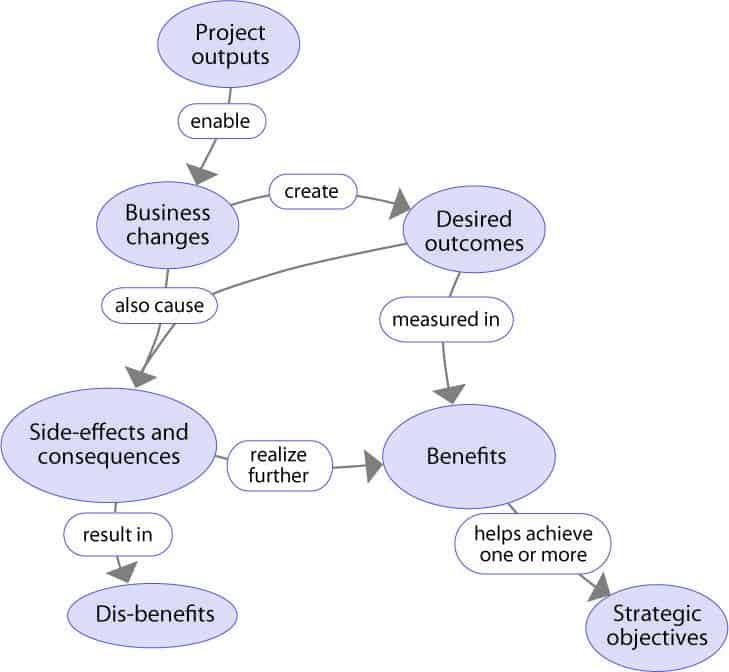Outputs, outcomes and benefits
What is the difference between outputs, outcomes and benefits? Answering this question correctly is vital to your success in project, program and portfolio management.
Outputs
Outputs are deliverables or products created in your project. These products can be physical things such as buildings or software programs, or intangible things such as policies. PRINCE2 projects produce outputs
Outcomes and Benefits
By themselves, outputs do absolutely nothing. When that output is used it generates business changes which are outcomes. When we measure those business changes, these are benefits. MSP and MoP deal with outcomes and benefits.
What is my project objective?
When you are assigned as the project manager on a new project, one of the first questions to ask is “What is the objective of this project?” Not that you want to challenge what the project is trying to accomplish, but rather to gather a better understanding of what you are being asked to do. What is the objective question? Our objective is to BUILD X. When you are told what it is you are creating, we need to pursue the discussion further with the Senior Users and those representing our user communities and ask what business changes do you expect to see when using X? Some examples of these outcomes might include – we expect to see:
- Faster processing of customer orders.
- Fewer defects in the manufacturing process.
- An increase in our sales activities.
- Fewer customer complaints.
- Increased activity on our website.
Side effects and consequences
PRINCE2 also discusses the idea of side effects and consequences. Those outcomes that were unforeseen but happen anyway. These side effects and consequences may have a positive (more benefits) result or a negative (dis-benefits) results. As an example, a company creates a new web-store to allow customers who cannot travel to their store to order online. The expected outcome is more orders and sales. If the web-store also allows people to view the range of products that the company sells and therefore brings more people into their physical store, this would be seen as a positive side-effect.
From outcomes to benefits
When we measure the outcomes, these turn into benefits. For example:
- Reduce the processing time for customer orders by at least 20 % from the current measure of 15 minutes.
- Add a minimum of 20 new customers each month for the next year.
- Increase new visitors to our website by an average of 25% a month for the next year.
What is the objective question? Our objective is to increase our sales. This response prompts us to ask, how much of an increase in sales, so we can establish benefits. But also to ask, what do we need to create to generate that increase in sales? What is the objective question? Our objective is to get 20 new customers per month for the next year. This response prompts us to ask, what business changes are required to enable us to get these new customers and what do we need to create to enable those business changes?
Outputs, Outcomes and Benefits
The beauty of the relationship between outputs, outcomes and benefits is that the conversation can start from any of the 3 words and be expanded to encompass all of them. To further expand the conversation, PRINCE2 also mentions Strategic Objectives and links this to benefits. This is a fourth dimension that can be added into the discussion. All of these discussions allow for greater understanding of the project and will result in a better definition of what this project is looking to achieve. It will result in a much more meaningful business case and project brief and enable a better decision on whether or not to initiate this project. PRINCE2 gives a great graphic showing the relationship between outputs, outcomes and benefits in the Business Case Theme chapter. It is great way to engage your key stakeholders in conversations to fully understand what is the objective of this project?

How do Outputs, Outcomes and Benefits relate to PRINCE2, MSP and MoP?
The explanations in this post are common to PRINCE2 projects, MSP programs and MoP portfolio management. PRINCE2 projectsPRINCE2 projects produce outputs. PRINCE2 says that benefits will usually happen after a product has been used for some time. Following its own Continuous Business Justification principle, PRINCE2 sets up a Benefits Realization Plan and assigns benefits owners who will be responsible for benefits realization after the project has closed. MSP Programs co-ordinate related projects to achieve outcomes and realize benefits. MSP has 2 transformational flow processes to do this. Delivering the Capability and Realizing the Benefits. MoP Project Portfolio management ensures that the right projects and programs are selected that will achieve the benefits desired by the organization’s strategy.
